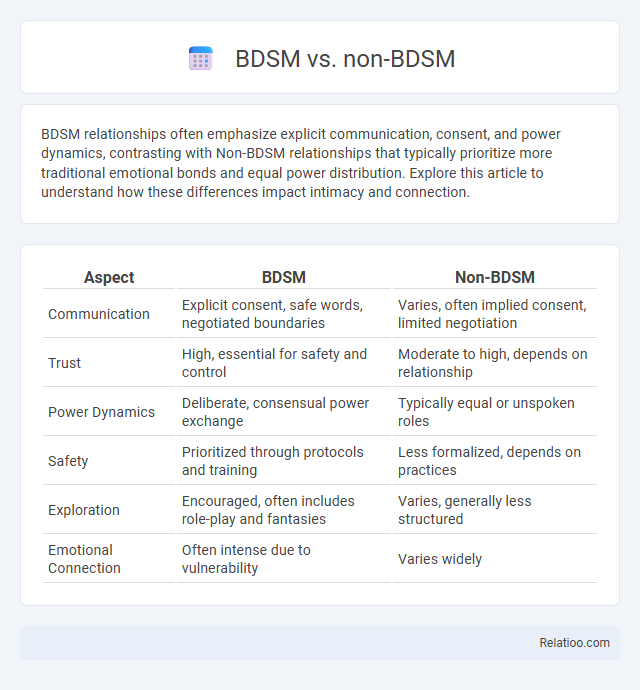BDSM relationships often emphasize explicit communication, consent, and power dynamics, contrasting with Non-BDSM relationships that typically prioritize more traditional emotional bonds and equal power distribution. Explore this article to understand how these differences impact intimacy and connection.
Table of Comparison
| Aspect | BDSM | Non-BDSM |
|---|---|---|
| Communication | Explicit consent, safe words, negotiated boundaries | Varies, often implied consent, limited negotiation |
| Trust | High, essential for safety and control | Moderate to high, depends on relationship |
| Power Dynamics | Deliberate, consensual power exchange | Typically equal or unspoken roles |
| Safety | Prioritized through protocols and training | Less formalized, depends on practices |
| Exploration | Encouraged, often includes role-play and fantasies | Varies, generally less structured |
| Emotional Connection | Often intense due to vulnerability | Varies widely |
Understanding BDSM: An Overview
BDSM encompasses a spectrum of consensual practices involving bondage, discipline, dominance, submission, sadism, and masochism, distinct from non-BDSM activities that lack power exchange dynamics or consensual kink elements. Non-BDSM sexual experiences typically focus on conventional intimacy without incorporating structured roles or ritualistic play central to BDSM. Experimentation serves as a bridge where individuals explore boundaries and preferences within or outside BDSM, fostering personal discovery and communication essential for safe, consensual engagement in diverse sexual expressions.
Defining Non-BDSM Relationships
Non-BDSM relationships are defined by the absence of consensual power exchange, kink, or BDSM-specific dynamics, emphasizing conventional intimacy and communication methods. These relationships prioritize mutual respect, emotional connection, and equal partnership without incorporating BDSM practices such as bondage, dominance, or submission. Experimentation often involves exploring the boundaries between BDSM and non-BDSM dynamics, allowing partners to discover personal preferences and negotiate consent-based experiences.
Core Differences: Consent and Communication
Core differences between BDSM, non-BDSM, and experimentation revolve around consent and communication, with BDSM emphasizing explicit, negotiated consent and detailed discussion of boundaries and limits before engagement. Non-BDSM interactions may rely on implicit or assumed consent, often without structured communication about specific preferences or limits. Your safety and satisfaction in any sexual context depend on clear, ongoing communication and mutual consent tailored to the activities you choose to explore.
Dynamics of Power Exchange
BDSM practices emphasize consensual power exchange involving dominance and submission, where roles are clearly defined and negotiated for mutual satisfaction and trust. Non-BDSM relationships typically maintain egalitarian dynamics without explicit power play, focusing on balanced emotional and decision-making roles. Experimentation with power exchange allows individuals to explore varying degrees of control and submission, often blending elements from both BDSM and non-BDSM interactions to discover personal boundaries and preferences.
Safety Practices: Risk-Awareness in Both Lifestyles
BDSM safety practices emphasize informed consent, clear communication, and the use of safewords to manage risk and ensure participants' well-being during scenes. Non-BDSM sexual experimentation requires similar attention to boundaries, mutual understanding, and awareness of physical and emotional risks to foster trust and prevent harm. Both lifestyles benefit from thorough education on risks, regular check-ins, and respect for personal limits to promote a safe and consensual experience.
Emotional Intimacy: BDSM vs Non-BDSM
BDSM often fosters deep emotional intimacy through trust, communication, and vulnerability that are integral to the dynamics between participants. Non-BDSM relationships may develop emotional closeness through traditional expressions of affection and shared experiences without the intense negotiation of boundaries. Your emotional connection can vary significantly depending on whether the relationship involves BDSM practices or non-BDSM interactions, with experimentation offering a way to explore these differences.
Role of Trust and Boundaries
Trust serves as the foundation in both BDSM and non-BDSM relationships, with clear boundaries ensuring mutual respect and emotional safety. In BDSM, explicit communication about limits and consent is paramount, empowering you to explore desires within a secure framework. Experimentation often bridges the two, allowing partners to define and renegotiate boundaries while deepening trust through open dialogue and understanding.
Exploring Stereotypes and Myths
BDSM practices often face misconceptions portraying participants as violent or psychologically damaged, contrasting with the mainstream non-BDSM community where intimacy is viewed as conventional and non-consensual elements are stigmatized. Experimentation blurs these lines by allowing individuals to explore desires beyond stereotypes, promoting consent, safety, and communication as foundational principles. Research indicates that consensual BDSM participants report equal or higher levels of psychological well-being compared to non-BDSM practitioners, challenging myths about mental health and deviance.
Personal Fulfillment and Sexual Expression
Personal fulfillment in BDSM often stems from exploring power dynamics and trust, enhancing intimacy through consensual role-play and boundary-pushing experiences. Non-BDSM sexual expression typically emphasizes mutual pleasure and emotional connection without engaging in dominant-submissive roles or intense physical sensations. Experimentation blends elements of both, allowing individuals to discover new aspects of their sexuality and personal identity, fostering growth and a deeper understanding of desires.
Choosing What’s Right for You
Choosing between BDSM, non-BDSM, and experimentation depends on personal comfort, boundaries, and desires. BDSM involves consensual power dynamics and specific practices that may appeal to those seeking intense sensations or emotional connections, while non-BDSM relationships typically emphasize traditional intimacy without such elements. Experimentation allows individuals to explore different experiences safely, helping to identify preferences and boundaries that best align with their identity and relationship goals.

Infographic: BDSM vs Non-BDSM
 relatioo.com
relatioo.com